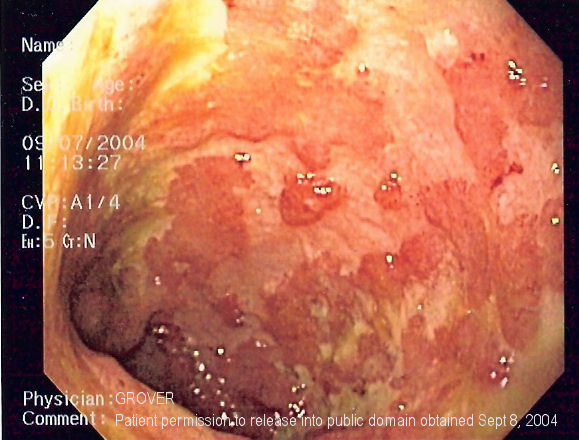Ulcerative colitis differential diagnosis
|
Ulcerative colitis Microchapters |
|
Diagnosis |
|---|
|
Treatment |
|
Case Studies |
|
Ulcerative colitis differential diagnosis On the Web |
|
American Roentgen Ray Society Images of Ulcerative colitis differential diagnosis |
|
Risk calculators and risk factors for Ulcerative colitis differential diagnosis |
Editor-In-Chief: C. Michael Gibson, M.S., M.D. [1]
Differentiating Ulcerative Colitis from other Diseases
The following conditions may present in a similar manner as ulcerative colitis, and should be excluded:
- Crohn's disease
- Infectious colitis, which is typically detected on stool cultures
- Pseudomembranous colitis, or Clostridium difficile-associated colitis, bacterial upsets often seen following administration of antibiotics
- Ischemic colitis, inadequate blood supply to the intestine, which typically affects the elderly
- Radiation colitis in patients with previous pelvic radiotherapy
- Chemical colitis resulting from introduction of harsh chemicals into the colon from an enema or other procedure.

Comparison to Crohn's Disease
The most common disease that mimics the symptoms of ulcerative colitis is Crohn's disease, as both are inflammatory bowel diseases that can affect the colon with similar symptoms. It is important to differentiate these diseases, since the course of the diseases and treatments may be different. In some cases, however, it may not be possible to tell the difference, in which case the disease is classified as indeterminate colitis.
| Crohn's Disease | Ulcerative Colitis | |
|---|---|---|
| Involves terminal ileum? | Commonly | Seldom |
| Involves colon? | Usually | Always |
| Involves rectum? | Seldom | Usually |
| Peri-anal involvement? | Commonly | Seldom |
| Bile duct involvement? | Not associated | Higher rate of Primary sclerosing cholangitis[1] |
| Distribution of Disease | Patchy areas of inflammation | Continuous area of inflammation |
| Endoscopy | Linear and serpiginous (snake-like) ulcers | Continuous ulcer |
| Depth of inflammation | May be transmural, deep into tissues | Shallow, mucosal |
| Fistulae, abnormal passageways between organs | Commonly | Seldom |
| Biopsy | Can have granulomata | |
| Surgical cure? | Often returns following removal of affected part | Usually cured by removal of colon, can be followed by pouchitis |
| Smoking | Higher risk for smokers | Lower risk for smokers |
| Autoimmune disease? | Generally regarded as an autoimmune disease | No consensus |
| Cancer risk? | Lower than ulcerative colitis | Higher than Crohn's |
References
- ↑ Broome U, Bergquist A. Primary sclerosing cholangitis, inflammatory bowel disease, and colon cancer. Semin Liver Dis 2006 February;26(1):31-41. PMID 16496231.